A jet lagged passenger left a cup of tea (of mass 0.1 kg) on their tray table before exiting the train. The maximum acceleration that the train can reach before the cup starts sliding is \(2 \, \text{m}/{\text{s}^2}\).
(a) What is the coefficient of static friction between the tray and the cup?
(b) What is the magnitude and direction of the total force exerted by the cup on the tray when the train accelerates at \(2 \, \text{m}/{\text{s}^2}\)?
a) There is only one force acting along the \({x-}\)axis. The sum of forces in the \({x-}\)direction must be proportional to the acceleration of the train.
b) Find the \({x-}\) and \({y-}\) components of the forces, and the magnitude will be obtained by Pythagorean theorem.
a) Newton’s Second Law along the \({x-}\)direction is:
\begin{equation*}
f_r = ma_x ,
\end{equation*}
where \(f_r= \mu_e N\).
Newton’s Second Law along the \({y-}\)direction is:
\begin{equation*}
N – mg = 0.
\end{equation*}
Using both relations combined with some algebra, we get:
\begin{equation*}
\mu_e = \frac{a_x}{g},
\end{equation*}
to get:
\begin{equation*}
\mu_e=0.2.
\end{equation*}
b) The cup exerts two forces on the tray: a normal force and a friction force. From Newton’s Third Law, it follows that the normal force and the static friction that the cup exerts on the tray must have the same magnitude as the normal force and the static friction that the tray exerts on the cup, respectively.
The magnitude of the total force that the cup makes over the tray is given by:
\begin{equation*}
F_T = \sqrt{ (N_T)^2 + (f_{rT})^2 },
\end{equation*}
to get:
\begin{equation*}
F_T = 1.0002 \, \text{N}.
\end{equation*}
Thus, the angle between the forces is given by
\begin{equation*}
\tan \theta = \frac{N_T}{f_{rT}}.
\end{equation*}
Thus,
\begin{equation*}
\theta = 78.5^\circ.
\end{equation*}
For a more detailed explanation of any of these steps, click on “Detailed Solution”.
(a) In order to find the coefficient of static friction between the tray and the cup, we need to relate this coefficient to the maximum acceleration that the cup can reach before sliding (which we know). Notice that the maximum acceleration that the train can reach before the cup slides must be the same as the maximum acceleration the cup can reach before sliding. (If these accelerations were not the same, then the cup would be sliding!) Since the only horizontal force on the cup is the static friction produced by the tray, in order to find the coefficient of static friction, we need to consider Newton’s equations.
If we choose a system of coordinates where the \({x-}\)axis points in the direction of motion, then we see that there is only one force in \({x}\): the static friction produced by the tray. This force points in the direction of motion because it is the force that allows the cup to move with the train. In \({y}\), there are two forces, the weight, and the normal force produced by the tray. Thus, the force diagram can be seen in Figure 1.
Figure 1: Force diagram on the cup. The forces shown are the contact force \(N\), the weight \(W\) and the friction \(fr\). The coordinate system is chosen with X along the horizontal in the direction of the train’s motion and Y in the vertical.
Now, let’s write Newton’s Second Law along the \({x-}\)direction:
\begin{equation}
\label{CupTea_sumatoriaFuerzasX}
f_r \, \hat{\textbf{i}} = ma_x \, \hat{\textbf{i}}.
\end{equation}
The maximum acceleration of the cup must be given by the maximum static friction from the tray. And we know that the maximum static friction is always given by \(\mu_e N\), where \(\mu_e\) is the coefficient of static friction. (When the static friction is not maximum, then it is not given by \(\mu_e N\)).) Thus, equation \eqref{CupTea_sumatoriaFuerzasX} yields
\begin{equation}
\label{CupTea_sumatoriaFuerzasXFriccion}
\mu_e N \, \hat{\textbf{i}} = ma_x \, \hat{\textbf{i}},
\end{equation}
where \(a_x\) here will be the maximum acceleration the cup can have. Let’s focus only on the magnitudes:
\begin{equation}
\label{CupTea_sumatoriaFuerzasXMagnitud}
\mu_e N = ma_x.
\end{equation}
Now we need to find \(N\). To do so, consider the force equations in \({y}\):
\begin{equation}
\label{CupTea_sumatoriaFuerzasY}
N \, \hat{\textbf{j}} – W \, \hat{\textbf{j}} = m a_y \, \hat{\textbf{j}}.
\end{equation}
Since the cup does not accelerate along \({y}\), and since \(W=mg\), we get:
\begin{equation}
\label{CupTea_sumatoriaFuerzasYmg}
N \, \hat{\textbf{j}} – mg \, \hat{\textbf{j}} = 0 \, \hat{\textbf{j}}.
\end{equation}
Thus,
\begin{equation}
\label{CupTea_NormalVector}
N \, \hat{\textbf{j}} = mg \, \hat{\textbf{j}}.
\end{equation}
If we focus on the magnitudes, we get
\begin{equation}
\label{CupTea_NormalMagnitud}
N=mg.
\end{equation}
Let’s use this in equation \eqref{CupTea_sumatoriaFuerzasXMagnitud}:
\begin{equation}
\mu_e {(mg)} = m a_x
\end{equation}
Then, if we divide by \(mg\), we get:
\begin{equation}
\mu_e = \frac{a_x}{g}.
\end{equation}
Finally, let’s insert the numerical values:
\begin{equation}
\mu_e = \frac{{(2 \, \text{m/s}^2)}}{{(9.8 \, \text{m/s}^2)}},
\end{equation}
to get:
\begin{equation}
\mu_e = 0.2.
\end{equation}
(b) The cup exerts two forces over the tray, a normal force and a friction force. Thus, the total force of the cup over the tray is given by the vectorial sum of these two forces:
\begin{equation}
\vec{F}_T=\vec{N}+\vec{fr}
\end{equation}
From Newton’s Third Law, it follows that the normal force that the cup exerts on the tray is of the same magnitude as the normal force that the tray exerts on the cup. And the magnitude of the static friction that the tray exerts on the cup is the same as the one the cup exerts on the tray.
The normal force on the cup has magnitude \(mg\) and points in the positive Y axis, and so the normal force the cup produces on the tray is of the same magnitude but in the opposite direction:
\begin{equation}
N_t \, \hat{\textbf{j}} = -mg \, \hat{\textbf{j}}.
\end{equation}
The static friction the tray makes on the cup is given by equation \eqref{CupTea_sumatoriaFuerzasX} from (a). Thus, the static friction the cup makes on the tray is the same but in the opposite direction:
\begin{equation}
f_{rt} \, \hat{\textbf{i}} = -ma_x \, \hat{\textbf{i}}.
\end{equation}
So, the forces that the cup exerts on the tray are shown in figure 2.
Figure 2: Forces exerted by the cup on the tray. The forces are the contact force \(N_T\) and the friction force \(f_{rT}\). From Newton’s third law the magnitude of these forces is the same as \(N\) and \(f_r\) exerted on the cup.
Since these two forces are perpendicular, then the magnitude of the total force that the cup makes over the tray is given by
\begin{equation}
F_T = \sqrt{ (N_T)^2 + (f_{rT})^2 }.
\end{equation}
Using the expressions we found for the normal force and the friction force above, we get:
\begin{equation}
F_T = \sqrt{({-mg})^2 + ({-ma_x})^2}.
\end{equation}
Let’s insert the numerical value here:
\begin{equation}
F_T = \sqrt{\bigg(-{(0.1\, \text{kg})}{(9.8 \, \text{m/s}^2)}\bigg)^2 + \bigg(-{(0.1\, \text{kg})} {(2 \, \text{m/s}^2)}\bigg)^2},
\end{equation}
to get:
\begin{equation}
F_T = 1.0002 \, \text{N}.
\end{equation}
Finally, the direction of the force can be easily calculated by noticing the angle between the two forces. In particular, consider figure 3.
Figure 3: Angle \(\theta\) between the total force \(F_T\) on the tray exerted by the cup and the horizontal line.
Thus, the angle between the forces is given by
\begin{equation}
\tan \theta = \frac{-mg}{-ma_x}.
\end{equation}
Thus,
\begin{equation}
\theta = 78.5^\circ.
\end{equation}
So, the magnitude of the force is \(1.0002 \, \text{N}\), and the direction is given by \(\theta = 78.5^\circ\), as indicated in the figure.
You need to be registered and logged in to take this quiz. Log in

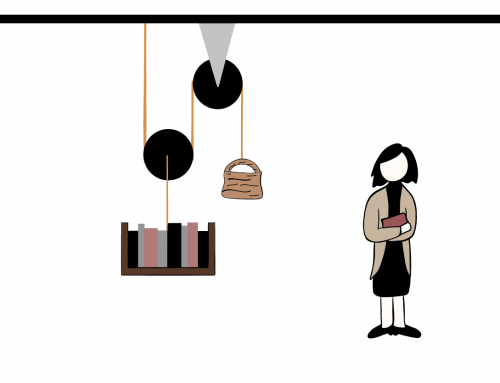
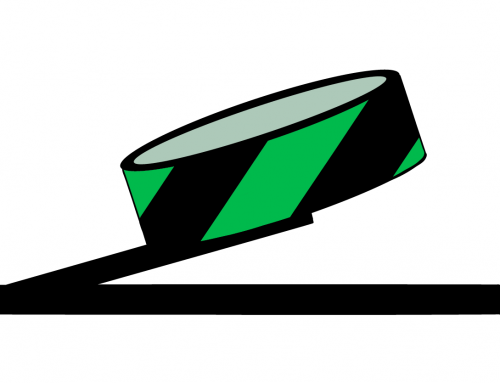
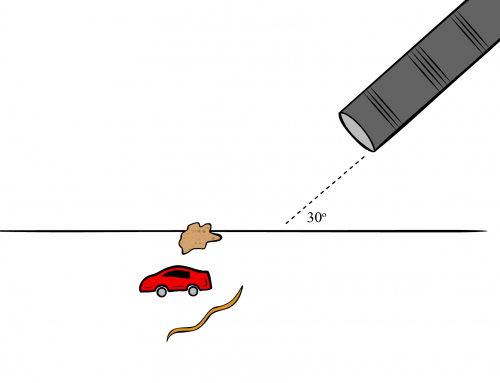
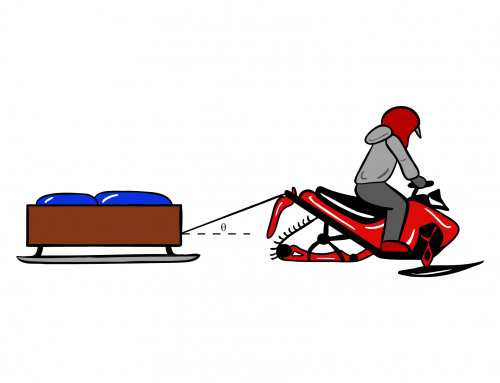
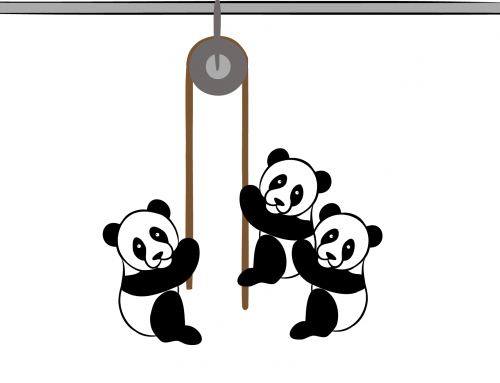
Leave A Comment